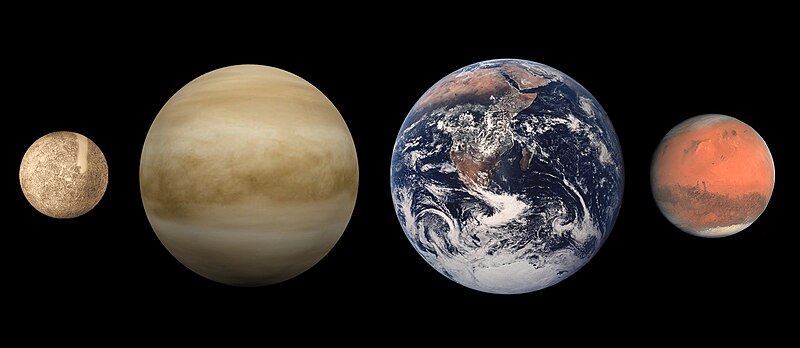Fiùra:Terrestrial planet size comparisons.jpg
Aspetto

Dimenziune 'e sta anteprimma: 800 × 348 pixel. Ati resoluziune: 320 × 139 pixel | 640 × 279 pixel | 1 500 × 653 pixel.
File 'e origgine (1 500 × 653 pixel, dimenzione ddo file: 314 KB, tipo MIME: image/jpeg)
Cronologgia d’’o file
Fa’ clic ncoppa a na data/ora pe vedé comme s'appresentava 'o file a chillo mumento.
| Data/Ora | Miniatura | Dimenzione | Utente | Commento | |
|---|---|---|---|---|---|
| attuale | 21:39, 4 dic 2018 |  | 1 500 × 653 (314 KB) | Allice Hunter | Correcting Mars |
| 18:21, 3 dic 2018 |  | 1 500 × 653 (315 KB) | Allice Hunter | updated: correcting the color of Mars. Based on image of Mars >> File:OSIRIS Mars true color.jpg. There was no distortion in size | |
| 23:37, 15 lug 2012 |  | 1 500 × 653 (276 KB) | Ubiquinoid | updated: correcting for apparent undersizing of Venus (from 90 to 95% (true) of Earth's diameter) - based on image of Venus w/NASA cloup map (resized) at http://cronodon.com/PlanetTech/Venus.html; centred | |
| 15:52, 15 lug 2012 |  | 1 500 × 653 (79 KB) | Ubiquinoid | updated: correcting for apparent undersizing of Venus (95% of Earth's diameter) - based on image of Venus w/cloup map (resized) at http://cronodon.com/PlanetTech/Venus.html | |
| 00:50, 28 dic 2007 |  | 1 500 × 653 (456 KB) | Crotalus horridus~commonswiki | Created identical and more compact version using the "Huffman optimized" feature of jpegcrop. Nothing else has been changed. | |
| 00:27, 15 Giù 2006 |  | 1 500 × 653 (488 KB) | Nicke L | {{Information| |Description= The inner planets, from left to right: en:Mercury, en:Venus, en:Earth, and en:Mars Source: http://solarsystem.nasa.gov/multimedia/gallery/terr_sizes.jpg |Source= |Date= |Author=User [[:en:User:Brian0918|Br |
Jonte ê ffiure
Pe' nisciuna paggena ce buò stu file.
Auso globbale d’’o file
'E wiki ccà abbascio aúsano stu file:
- Uso ncopp'a af.wikipedia.org
- Uso ncopp'a arz.wikipedia.org
- Uso ncopp'a az.wikipedia.org
- Uso ncopp'a bat-smg.wikipedia.org
- Uso ncopp'a ba.wikipedia.org
- Uso ncopp'a be-tarask.wikipedia.org
- Uso ncopp'a beta.wikiversity.org
- Uso ncopp'a be.wikipedia.org
- Uso ncopp'a bxr.wikipedia.org
- Uso ncopp'a ca.wikipedia.org
- Uso ncopp'a cv.wikipedia.org
- Uso ncopp'a da.wikipedia.org
- Uso ncopp'a da.wikisource.org
- Uso ncopp'a de.wikipedia.org
- Uso ncopp'a de.wikisource.org
- Uso ncopp'a de.wikiversity.org
- Uso ncopp'a en.wikipedia.org
- User:Can't sleep, clown will eat me
- User:Newone
- Wikipedia:Featured picture candidates/Terrestrial planet size comparisons
- Wikipedia:Featured picture candidates/May-2006
- Talk:Dwarf planet/Archive 1
- Wikipedia:Featured picture candidates/February-2007
- Wikipedia:Featured picture candidates/Terrestrial planets
- User:Can't sleep, clown will eat me/User/appetizers
- Wikipedia:Featured picture candidates/August-2007
- Wikipedia:Featured picture candidates/Terrestrial planet size comparisons.jpg
- User:Mitternacht90/EarthandSpace
- User:HarryAlffa/Solar System synopsis
- Talk:Solar System/Archive 5
- User:Physchim62/Planetmass
Vedite ause globbale 'e stu file.


